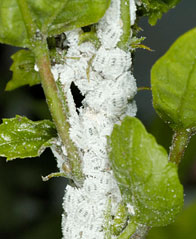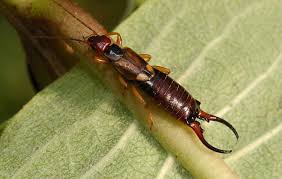Thrips are small enough that most of the time you won’t know they’re there, and the damage they inflict on plants is often confusing and can lead one to believe that something else is responsible. And often when I’m assessing a problematic plant and mention them, people will frown and ask, ‘What are thrips?’
Thrips are a minute less than 1mm, slender insects with fringed wings and unique asymmetrical mouthparts. Different thrips species feed mostly on plants by puncturing  and sucking up the contents, although a few are predators.
and sucking up the contents, although a few are predators.
Thrips primarily feed on new growth of leaves, flowers, and fruit, the damage they do is often caused before this new growth develops fully: flowers and leaves then open with distorted shapes, necrotic patches and streaks that can resemble disease, mechanical damage or nutrient deficiency. They can also feed on matured foliage, leaving behind silverish patches which in some species can become bronze-coloured or corky with time. Thrips are quite tiny, and when hidden deep in a flower bud or the like can be practically invisible. Knocking the plant part while holding it above a white sheet of paper will often dislodge a few and reveal their presence, and they do leave dark little globs of faeces near feeding damage as well.
The most obvious contribution that thrips make to their ecosystem is the damage they can cause during feeding. They feed on flowers, buds, under leaves, or other hidden areas of growing plant parts such as central terminals. This sneaky habit is what makes it hard to control them. Citrus thrips can occur on most fruit trees, California pepper trees, and pomegranate. That infestation is indicated by yellow to brownish scabby feeding scars that form on fruit, often in a ring around the citrus stem. 
The damage from flower thrips can be discoloration and stippling. The more common damage seen is the bleaching and stippling of leaves. The once green leaves take on a silvery appearance and when you turn the damaged leaf over you will notice the tiny black excrement specks. They look like tiny drops of oil. They fly only weakly and their feathery wings are unsuitable for conventional flight; instead, thrips exploit an unusual mechanism, clap, and fling, to create lift using an unsteady circulation pattern with transient vortices near the wings. They are capable of flight and also of being carried by the breeze due to their tiny size.
Thrips can also be a nuisance because of their small size. They are able to get into strange places like the inside of a picture frame or LCD television. Imagine the expense of taking your TV apart to extract a wayward thrip. And, to top it off, thrips can bite. The bite can create an irritating, itchy bump.
The main challenges are with their management by chemical means; as they reproduce so quickly, they are able to just as quickly develop resistance to insecticides, and thus this only offer a measure of control for a short time before they are useless.
Let us look at some evidence:
Coffee pest outbreak threatens Kenya’s yield
May 18th, 2017, Standard digital
Coffee pest outbreak threatens Kenya’s yield. Kenya’s coffee output could be adversely affected following an outbreak of thrips in one of the most productive parts of Central Kenya.
The outbreak has hit all coffee-growing zones in Mwea East and Mwea West sub-counties due to what experts said were prolonged drought conditions under which the pest thrives best. Gitari Ndambiri from Kiamichiri village, whose 500 coffee trees have been attacked by the pest, said he had not appreciated the magnitude of the attack until recently. “Towards the end of March, I started noticing some leafs turning grey from underneath, but I did not get bothered since I thought it was due to the prevailing drought,” he said.
According to John Kimani, an industrial crops scientist, thrips have the capacity to obliterate entire crops if untamed.
He said coffee yields could drop by up to 5,000 metric tonnes per season unless farmers unless continuous spraying is done.
Georgia cotton growers having a tough time with thrips
By Phillip Roberts, Georgia Extension Entomologist, Southeast farm press, May 31, 2013
Infestations vary across the state of Georgia, but as a whole, this has been a tough thrips year. Cotton planted in late April and early May grew off slowly which exacerbated (made worse) plant injury symptoms associated with thrips feeding. Thrips numbers were only moderate during the first half of May but plant injury was severe in some areas.
Beginning late last week (about May 23), thrips numbers significantly increased in many areas. We normally expect the peak in thrips populations to occur earlier, but the peak appears to be later than normal.
As stated earlier some species of thrips feed on other insects or mites and are considered beneficial, while some feed on fungal spores or pollen. Hence they hold a lot of ecological importance in our ecosystem. In many thrips species, by the time their damage is observed, such as after buds open, the thrips may no longer be present. Thus instead of taking controlling remedies, one must look for effective preventive measures.
The main challenge is with their management by chemical means; as they reproduce so quickly, they are able to just as quickly develop resistance to insecticides, and thus this only offer a measure of control for a short time before they are useless. Irresponsible use of these chemicals by producers (failing to rotate chemicals, calendar spraying, and incorrect technique) have not helped the situation, and in fact, probably the most widespread of these beasts in Canadian ornamental horticulture, the western flower thrips, is now resistant to most chemical insecticides.
But before your despair causes you to throw your scarred old plants and crops, wait there is a hope.
At C Tech Corporation we offer a safe and effective solution to deal with these insects. Combirepel™ is a non-toxic, non-hazardous product that primarily repels insects from the application. The best feature of this product is that it is environmentally safe and causes no harm to insects as well as for humans.
Combirepel™ product is available in the form of the masterbatch, liquid concentrate, and lacquer. Combirepel™ is a non-toxic, non-hazardous broad-spectrum insect aversive masterbatch which works not only against termites but a host of other insects.
Combirepel™ masterbatch can be incorporated into different kinds of agricultural films, tree guards, mulches, etc. and is found to be effective against the most aggressive insects. These films can also be wrapped around fruits to prevent damage.
The liquid concentrate can be mixed with paints in a pre-determined ratio and can be applied to the concrete fence around farms and garden. The liquid concentrate is compatible with all types of paints and solvents.
The lacquer can be used as a direct application and can be applied as a topical application on the wooden fences, already installed tree guards, pipes etc. to keep pest away from the trees.
Our product works on the mechanism of repellency. It temporarily inhibits the mating cycle of the insects. The product impairs the ability of the insects to reproduce, that is the insects will not lay eggs or the laid eggs will be infertile. The product causes feeding disruption in an insect by triggering an unpleasant reaction within the insect which might try to feed on the application. The product temporarily blocks the reproduction system of the insects by hindering the release of the vital hormones for growth.
All this can be done by just repelling the insect and not killing them. Thus, following the course of ecological balance and sustainability.
Combirepel™ is thermally stable and does not degrade on exposure to heat and sunlight. It does not kill or harm the insect but repels them. It does not volatilize and does not degrade the soil. It is RoHS, RoHS2, ISO, REACH, APVMA, NEA compliant and FIFRA exempted.
Contact us at technical.marketing@ctechcorporation.com to keep the pests away.
Also, visit our websites:
http://www.ctechcorporation.com/
http://www.rodrepel.com/
http://www.termirepel.com/
http://www.combirepel.com/
Follow our Facebook pages at:
1] https://www.facebook.com/Combirepel-411710912249274/
2] https://www.facebook.com/Termirepel-104225413091251/
3] https://www.facebook.com/Rodrepel-120734974768048/
Follow us on our Twitter pages at:
1] https://twitter.com/rodrepel
2] https://twitter.com/termirepel
3] https://twitter.com/combirepel

















